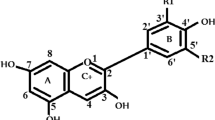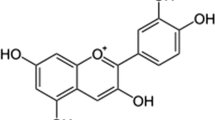Abstract
The Box Behnken design has been employed to study the synergy between three extraction parameters, i.e. extraction temperature, soaking period and trifluoroacetic acid (TFA) concentration in methanol solvent. The response of colour lightness, L*, saturation, S and anthocyanin content in the extract (mg/L) on varying these parameters were examined. The optimum parameters obtained from this study are 0.5% TFA-99.5% methanol, soaking time of 132.43 min and the extraction temperature of 80 °C. These values have the highest desirability of 0.942 and resulted in the highest anthocyanin yield of 4596 mg/L. The extract containing anthocyanin obtained under the optimal conditions was further evaluated as a sensitizer for the dye sensitized solar cells. Maximum solar conversion efficiency of 1.05% was achieved. Additionally, the DSSC fabricated using the extract from Melastoma malabathricum to 100 mW/cm2 simulated sunlight resulted in a short circuit photocurrent density (Jsc) of 1.3 mA, open circuit voltage (Voc) of 616 mV, and a fill factor (FF) of 57%.





Similar content being viewed by others
References
Anuar, N., Mohd Adnan, A.F., Saat, N., Aziz, N., Taha, R.M.: Optimization of extraction parameters by using response surface methodology, purification, and identification of anthocyanin pigments in melastoma malabathricum fruit. Sci. World J. (2013). https://doi.org/10.1155/2013/810547
Arifin, Z., Soeparman, S., Widhiyanuriyawan, D., Suyitno, S.: Performance enhancement of dye-sensitized solar cells using a natural sensitizer. Int. J. Photoenergy 5, 120–128 (2017)
Arunachalam, T., Rajarathinam, N.: Response surface optimization of critical extraction parameters for anthocyanin from Solanum melongena. J. Bioprocess Biotech. 1, 1–4 (2011). https://doi.org/10.4172/2155-9821.1000103
Borges, G.D.S.C., Vieira, F.G.K., Copetti, C., Gonzaga, L.V., Fett, R.: Optimization of the extraction of flavanols and anthocyanins from the fruit pulp of Euterpe edulis using the response surface methodology. Food Res Int. 44, 708–715 (2011). https://doi.org/10.1016/j.foodres.2010.12.025
Buscaino, R., Baiocchi, C., Barolo, C., Medana, C., Grätzel, M., Nazeeruddin, M.D.K., Viscardi, G.: A mass spectrometric analysis of sensitizer solution used for dyesensitized solar cell. Inorg. Chim. Acta 361, 798–805 (2008)
Cabrita, L., Fossen, T., Andersen, O.M.: Colour and stability of the six common anthocyanidin 3-glucosides in aqueous solutions. Food Chem. 68, 101–107 (2000). https://doi.org/10.1016/S0308-8146(99)00170-3
Ehret, A., Stuhl, L., Spitler, M.T.: Spectral sensitization of TiO2 nanocrystalline electrodes with aggregated cyanine dyes. J. Phys. Chem. 105, 9960–9965 (2001)
Espın, J.C., Soler-rivas, C., Wichers, H.J.: Characterization of the total free radical scavenger capacity of vegetable oils and oil fractions using 2,2-diphenyl-1-picrylhydrazyl radical. J. Agric. Food Chem. 48, 648–656 (2000)
Eisele, T., Giusti, M.M., Hofsommer, H., Koswig, S., Krueger, D.A., Kupina, S.: Determination of total monomeric anthocyanin pigment content of fruit juices, beverages, natural colorants, and wines by the pH differential Method: collaborative study. J. AOAC Int. 88, 1269–1277 (2005)
Fan, G., Han, Y., Gu, Z., Chen, D.: Optimizing conditions for anthocyanins extraction from purple sweet potato using response surface methodology (RSM). LWT Food Sci Technol. 41, 155–160 (2008)
Fernando, J.M.R.C., Senadeera, G.K.R.: Natural anthocyanins as photosensitizers for dye-sensitized solar devices. Curr. Sci. 95, 663–666 (2008)
Herbach, M.K., Stintzin, F.C., Carle, R.: Thermal degradation of betacyanins in juices from purple pitaya [Hylocereus polyrhizus (Weber) Brittonv & Rose] monitored by high-performance liquid chromatography-tandem mass spectometric analyses. Eur. Food Res. Technol. 219, 377–385 (2004)
Hamadanian, M., Safaei-Ghomi, J., Hosseinpour, M., Masoomi, R., Jabbari, V.: Uses of new natural dye photosensitizers in fabrication of high potential dye-sensitized solar cells (DSSCs) Mat. Sci. Semicon. Proc. 27, 733–739 (2014)
Hao, S., Wu, J., Huang, Y., Lin, J.: Natural dyes as photosensitizers for dye-sensitized solar cell. Sol. Energy 80, 209–214 (2006)
Jasim, K.E., Al-Dallal, S., Hassan, A.M.: Henna (Lawsonia inermis L.): dye-sensitized nanocrystalline titania solar cell. J. Nanotechnol. 90, 1–6 (2012)
Jinchu, J., Sreekala, C.O., Sreelatha, K.S.: Dye sensitized solar cell using natural dyes as chromophores—review. Mater. Sci. Forum 771, 39–51 (2014)
Joffry, S.M., Yob, N.J., Rofiee, M.S., Affandi, M.M.R.M.M., Suhaili, Z., Othman, F.: Melastoma malabathricum (L.) smith ethnomedicinal uses, chemical constituents, and pharmacological properties: a review. Evid. Based Complement. Altern. Med. (2012). https://doi.org/10.1155/2012/258434
John, G., Sangamithra, A., Chandrasekar, V.: Dyes and pigments response surface modeling and process optimization of aqueous extraction of natural pigments from beta vulgaris using Box Behnken design of experiments. Dye Pigment 111, 64–74 (2014). https://doi.org/10.1016/j.dyepig.2014.05.028
Ju, Z.Y., Howard, L.R.: Effects of solvent and temperature on pressurized liquid extraction of anthocyanins and total phenolics from dried red grape skin effects of solvent and temperature on pressurized liquid extraction of anthocyanins and total phenolics from dried red. J. Agric. Food Chem. 51, 5207–5213 (2003)
Liyana-Pathirana, C., Shahidi, F.: Optimization of extraction of phenolic compounds from wheat using response surface methodology. Food Chem. 93, 47–56 (2005)
Lapornik, B., Prošek, M., Wondra, A.G.: Comparison of extracts prepared from plant by-products using different solvents and extraction time. J. Food Eng. 71, 214–222 (2005)
Leydet, Y., Gavara, R., Petrov, V., Diniz, A.M., Parola, A.J., Lima, J.C.: The effect of self-aggregation on the determination of the kinetic and thermodynamic constants of the network of chemical. Phytochemistry 83, 125–135 (2012)
Ludin, N.A., Mahmoud, A.M.A., Mohamad, A.B., Kadhum, A.A.H., Sopian, K., Karim, N.S.A.: Review on the development of natural dye photosensitizer for dye-sensitized solar cells. Renew. Sustain. Energy Rev. 31, 386–396 (2014)
Maran, J.P., Manikandan, S.: Dyes and Pigments Response surface modeling and optimization of process parameters for aqueous extraction of pigments from prickly pear (Opuntia ficus-indica fruit. Dye Pigment. 95, 465–472 (2012)
Naczk, M., Shahidi, F.: Extraction and analysis of phenolics in food. J. Chromatogr. A 1054, 95–111 (2004). https://doi.org/10.1016/j.chroma.2004.08.059
Ooyama, Y., Harima, Y.: Photophysical and electrochemical properties and molecular structures of organic dyes for dye-sensitized solar cells. Chem. Phys. Chem. 13(18), 4032–4080 (2012)
Patore, M., Angelis, F.D.: Aggregation of organic dyes on TiO2 in dye-sensitized solarcells models: an ab initio investigation. ACS J. 4, 556–562 (2010)
Rein, M.J.: Copigmentation reactions and color stability of berry anthocyanins (2005). https://doi.org/10.1021/jf071205v
Sirat, H.M., Susanti, D., Ahmad, F., Takayama, H., Kitajima, M.: Amide, triterpene and flavonoids from the leaves of Melastoma malabathricum L. J. Nat. Med. 64, 492–495 (2010). https://doi.org/10.1007/s11418-010-0431-8
Spillmann, D., Burger, M.M.: Carbohydrate-carbohydrate interactions in adhesion. J. Cell. Biochem. 68, 562–568 (1996)
Santos, D.T., Meireles, M.A.A.: Jabuticaba as a source of functional pigments. Pharmacogn. Rev. 3, 127–132 (2009)
Wang, S., Chen, F.J., Wu, Z., Wang, X., Liao, X.: Optimization of pectin extraction assisted by microwave from apple pomace using response surface methodology. J. Food Eng. 78, 693–700 (2007). https://doi.org/10.1016/j.jfoodeng.2005.11.008
Wongcharee, K., Meeyoo, V., Chavadej, S.: Dye-sensitized solar cell using natural dyes extracted from rosella and blue pea flowers. Sol. Energy Mater. Sol. Cells 91, 566–571 (2007)
Wijngaard, H.H., Brunton, N.: The optimisation of solid–liquid extraction of antioxidants from apple pomace by response surface methodology. J. Food Eng. 96, 134–140 (2010). https://doi.org/10.1016/j.jfoodeng.2009.07.010
Wrolstad, R.E., Durst, R.W., Lee, J.: Tracking color and pigment changes in anthocyanin products. Trends Food Sci. Techol. 16, 423–428 (2005)
Yang, R.Y., Chen, H.Y., Lai, F.D.: Performance degradation of dye-sensitized solar cells induced by electrolytes. Adv. Mat. Sci. Eng. 23, 1–4 (2012)
Zhang, G., Bala, H., Cheng, Y., Shi, D., Luv, X., Yu, Q., Wang, P.: High efficiency and stable dyesensitized solar cells with an organic chromophore featuring a binary conjugated spacer. Chem. Commun. 16, 2198–2200 (2009)
Acknowledgements
The authors would like to thank University of Malaya, Kuala Lumpur, Malaysia for financial support PG172-2014B and the facilities provided
Author information
Authors and Affiliations
Corresponding author
Additional information
Publisher's Note
Springer Nature remains neutral with regard to jurisdictional claims in published maps and institutional affiliations.
Rights and permissions
About this article
Cite this article
Aziz, N., Mat Nor, N.A. & Arof, A.K. Optimization of anthocyanin extraction parameters from M. malabathricum via response surface methodology to produce natural sensitizer for dye sensitized solar cells. Opt Quant Electron 52, 24 (2020). https://doi.org/10.1007/s11082-019-2139-7
Received:
Accepted:
Published:
DOI: https://doi.org/10.1007/s11082-019-2139-7




